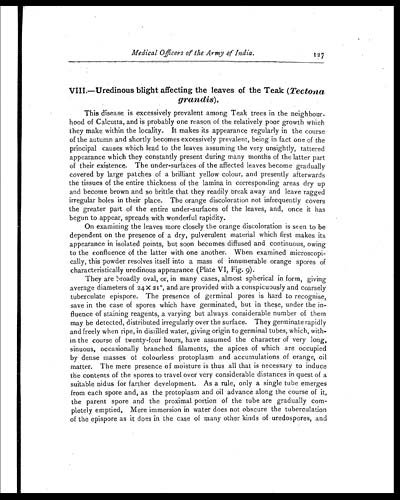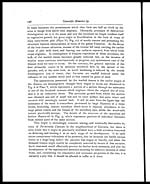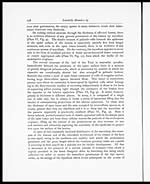Medicine - Institutions > Army health reports and medical documents > Scientific memoirs by medical officers of the Army of India > Part X, 1897 > 5 - On certain diseases of fungal and algal origin affecting economic plants in India
(148) Page 127
Download files
Individual page:
Thumbnail gallery: Grid view | List view

Medical Officers of the Army of India.
127
VIII.—Uredinous blight affecting the leaves of the Teak (Tectona
grandis ).
This disease is excessively prevalent among Teak trees in the neighbour-
hood of Calcutta, and is probably one reason of the relatively poor growth which
they make within the locality. It makes its appearance regularly in the course
of the autumn and shortly becomes excessively prevalent, being in fact one of the
principal causes which lead to the leaves assuming the very unsightly, tattered
appearance which they constantly present during many months of the latter part
of their existence. The under-surfaces of the affected leaves become gradually
covered by large patches of a brilliant yellow colour, and presently afterwards
the tissues of the entire thickness of the lamina in corresponding areas dry up
and become brown and so brittle that they readily break away and leave ragged
irregular holes in their place. The orange discoloration not infrequently covers
the greater part of the entire under-surfaces of the leaves, and, once it has
begun to appear, spreads with wonderful rapidity.
On examining the leaves more closely the orange discoloration is seen to be
dependent on the presence of a dry, pulverulent material which first makes its
appearance in isolated points, but soon becomes diffused and continuous, owing
to the confluence of the latter with one another. When examined microscopi-
cally, this powder resolves itself into a mass of innumerable orange spores of
characteristically uredinous appearance (Plate VI, Fig. 9).
They are broadly oval, or, in many cases, almost spherical in form, giving
average diameters of 24 X 21u, and are provided with a conspicuously and coarsely
tuberculate epispore. The presence of germinal pores is hard to recognise,
save in the case of spores which have germinated, but in these, under the in-
fluence of staining reagents, a varying but always considerable number of them
may be detected, distributed irregularly over the surface. They germinate rapidly
and freely when ripe, in distilled water, giving origin to germinal tubes, which, with-
in the course of twenty-four hours, have assumed the character of very long,
sinuous, occasionally branched filaments, the apices of which are occupied
by dense masses of colourless protoplasm and accumulations of orange, oil
matter. The mere presence of moisture is thus all that is necessary to induce
the contents of the spores to travel over very considerable distances in quest of a
suitable nidus for farther development. As a rule, only a single tube emerges
from each spore and, as the protoplasm and oil advance along the course of it,
the parent spore and the proximal portion of the tube are gradually com-
pletely emptied. Mere immersion in water does not obscure the tuberculation
of the epispore as it does in the case of many other kinds of uredospores, and
Set display mode to: Large image | Zoom image | Transcription
Images and transcriptions on this page, including medium image downloads, may be used under the Creative Commons Attribution 4.0 International Licence unless otherwise stated. ![]()
| Permanent URL | https://digital.nls.uk/75003498 |
|---|
| Shelfmark | IP/QB.10 |
|---|---|
| Additional NLS resources: | |




